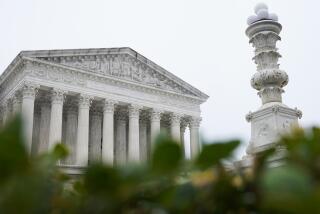Gala Day
- Share via
The United States has struggled for more than 30 years with how to remedy the effects of racial discrimination. One approach has been affirmative action, by which members of minorities receive preferential treatment over whites to make up for discriminatory practices in the past. But whites complain that this policy makes them the victims of racial discrimination in reverse.
Over the years the U.S. Supreme Court has wavered back and forth on this question, reflecting the deep and emotional division in the country concerning whether and in what circumstances affirmative action can be used. In its latest and one of its most sweeping pronouncements on the subject, the court ruled Wednesday that where bias in the past has been egregious or where its effects have lingered, it is legal to take race into account in hiring and promotion.
In two separate rulings that were a sharp rebuff to the Reagan Administration, the justices upheld court-ordered affirmative-action programs in Cleveland and New York that established racial quotas and timetables. The Administration’s efforts to destroy affirmative action were properly swept aside. The law “does not prohibit a court from ordering, in appropriate circumstances, affirmative race-conscious relief as a remedy for past discrimination,” Justice William J. Brennan Jr. wrote for the court.
The decisions mark a gala day in this country’s efforts to come to grips with the centuries of racial bias that continues to tear at the fabric of the United States. Though a “colorblind” society would be best, and someday will be, this country is far from realizing that goal. Affirmative action is both necessary and appropriate to its achievement.
Two years ago the Supreme Court struck down an affirmative-action plan in the Memphis fire department under which recently hired black employees were kept on while whites with more seniority were laid off. On the basis of that decision the Justice Department wrote to about 50 other localities around the country saying that their affirmative-action programs were no longer valid. On Wednesday, however, the court limited its earlier ruling to the facts of that case.
The Administration further asserted that preference should be accorded only to individuals who could show that they themselves had been the victims of discrimination. Once again the court on Wednesday said that the Administration was wrong. “The purpose of affirmative action is not to make identified victims whole,” Brennan wrote, “but rather to dismantle prior patterns of employment discrimination and to prevent discrimination in the future.”
In the Cleveland case the court upheld an agreement under which half of future promotions in the fire department must be reserved for minority candidates. In the New York case the court upheld a plan under which the union representing sheet-metal workers, which had once been all white, must be 29.3% nonwhite by August, 1987.
Though some may feel that innocent whites are disadvantaged by these plans, this is the correct social policy. Racism remains a part of our society. For the good of all, it must be overcome. The only way to do it is by insisting that these goals be met.
More to Read
Get the L.A. Times Politics newsletter
Deeply reported insights into legislation, politics and policy from Sacramento, Washington and beyond. In your inbox three times per week.
You may occasionally receive promotional content from the Los Angeles Times.










